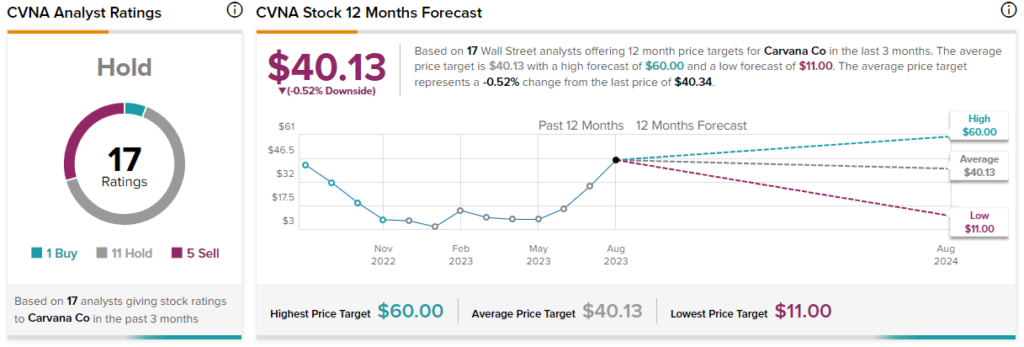As a momentum trade, it’s difficult to ignore the stratospheric rise of used-car retailer Carvana (NYSE:CVNA) this year. However, investors will probably want to avoid getting trapped into believing the company is worth saving. Though it’s harsh to frame it as such, the problem is that Carvana lacks a key advantage in the marketplace. Therefore, I am bearish on CVNA stock.
Maximize Your Portfolio with Data Driven Insights:
- Leverage the power of TipRanks' Smart Score, a data-driven tool to help you uncover top performing stocks and make informed investment decisions.
- Monitor your stock picks and compare them to top Wall Street Analysts' recommendations with Your Smart Portfolio

CVNA Stock Loses What It Once Had
During the worst of the COVID-19 crisis, public fear of the mysterious virus naturally kept people indoors. Moreover, companies that catered to largely contactless services performed well. Unsurprisingly, CVNA stock was no exception. Following the spring doldrums of 2020, shares began surging toward their peak price in the late summer of 2021.
Undergirding the fantastic rise of CVNA stock sat a pivotal market advantage. While Carvana’s baseline business of selling used cars was hardly unique, the way it went about its operations – delivering vehicles to customers’ homes directly – distinguished it from the brick-and-mortar competition. Of course, consumers had to pay a premium for the service, usually in the form of higher-than-average vehicle prices.
However, during a pandemic, customers were more than willing to pay up. During the worst of the crisis, few people wanted to be around strangers. Also, many naturally became skeptical about the safety of public transportation. So, Carvana inherently benefited from first-time or first-time-in-a-long-time buyers.
Nevertheless, as fears of COVID-19 faded, so too did CVNA stock. To be fair, inflationary pressures also negatively impacted the auto industry. Unfortunately, Carvana’s losses were particularly horrific. In hindsight, much of this pain likely stemmed from market share loss, as defined by U.S. Census Bureau data on used car dealers’ revenue haul.
In the fourth quarter of 2021, Carvana posted revenue of $3.75 billion. During the same period, all used car dealers posted sales of approximately $13.7 billion. This translated to CVNA having a 27.44% market share. Since then, the company has suffered significant losses relative to the competition. As of Q2 2023, its market share was 19.59%.
Fundamentals Don’t Bode Well for Carvana
For CVNA stock, the steep decline in market share indicates that the COVID-era catalyst of contactless services has lost much relevance. Folks simply don’t care about COVID-19. Just as worryingly, consumers hard-hit with economic pressures (such as high inflation) are seeking ways to save money. Thus, they probably won’t pay any unnecessary premiums, subsequently clouding the narrative for CVNA.
First, American consumers stand at a precarious crossroads thanks to profligacy. A new report shows that following a surge in credit card usage, many consumers have now turned to unsecured personal loans to essentially make ends meet. Unfortunately, several households lack the wherewithal to acquire a vehicle of any kind, let alone one from a premium service.
Second, ample evidence indicates that drivers are put off by still-high used-car prices. As S&P Global Mobility mentioned, the average age of vehicles on U.S. roadways has now hit a record 12.5 years. For sedans, this figure jumped to 13.6 years.
In other words, people are holding onto their rides for longer than ever. Obviously, that’s not a favorable backdrop for CVNA stock. Yes, eventually, these old cars will break down, forcing drivers to replace them. At that point, however, it makes better sense to negotiate a deal with a brick-and-mortar dealership. Or, folks can go to a private seller.
Sadly, the reality is that there are many other viable options besides Carvana.
Traders May be Sensing a Shift
Speaking of options, traders in the derivatives market may be anticipating a sentiment pivot in CNVA stock. Following the close of the August 18 session, the options chain for the expiration date of August 25, 2023, revealed some intriguing dynamics.
Specifically, the net change in open interest for out-of-the-money put options outnumbered that of call options by a margin of 443 to 428. Sure, it’s a tiny difference. However, this metric also indicates that skepticism may be brewing against CVNA stock.
For instance, the greatest change in open interest among the puts occurred for the options with a $36.5 strike price, with an open interest change of 238. Given that the change in price came out to -39.64%, traders may have identified a risk-reward opportunity in betting against CVNA stock.
Is Carvana Stock a Buy, According to Analysts?
Turning to Wall Street, CVNA stock has a Hold consensus rating based on one Buy, 11 Holds, and five Sell ratings. The average CVNA stock price target is $40.13, implying 0.5% downside potential.

The Takeaway: CNVA Stock is No Longer Special
Fundamentally, Carvana had its moment to shine during the COVID-19 crisis. That was when contactless business thrived. Today, consumers don’t care at all about contactless, especially if it means going “full contact” translates to financial savings. As such, it’s difficult to be long-term bullish on CVNA stock.









